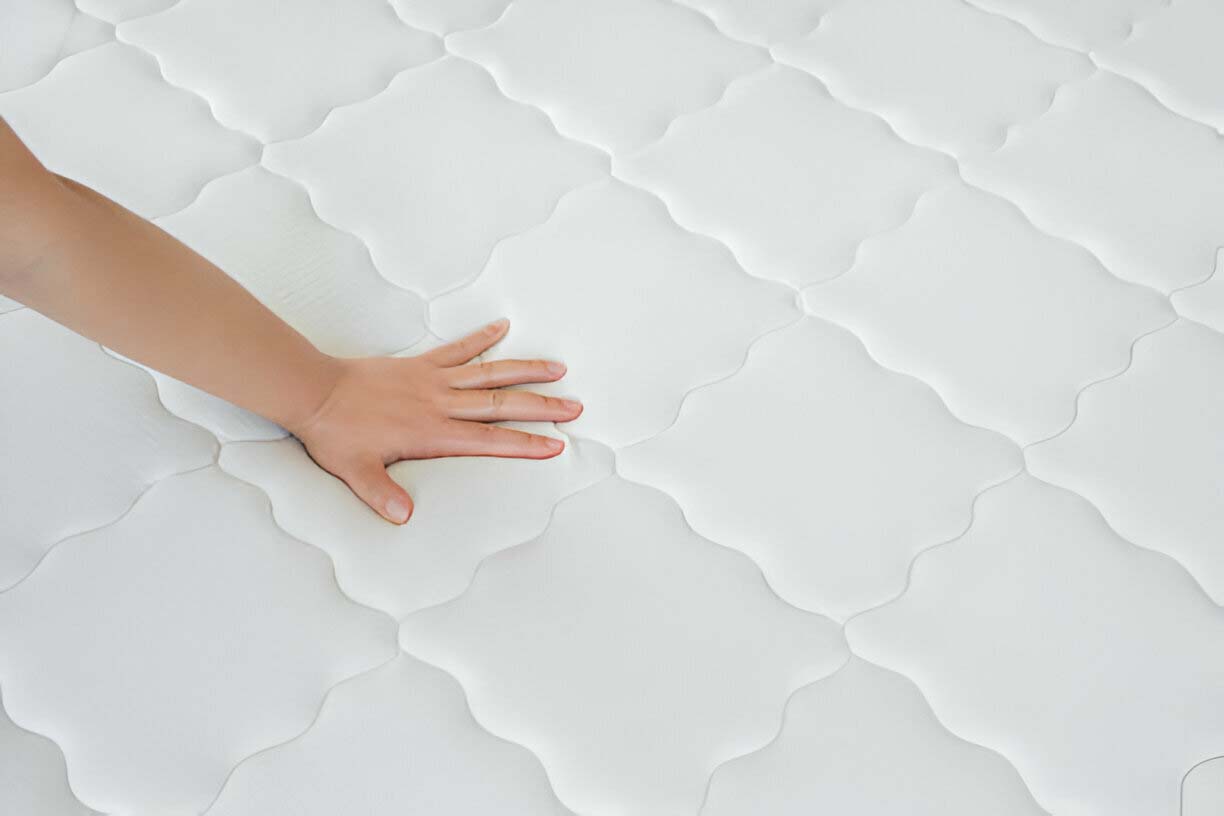Attention, sleep enthusiasts. While we all cherish the bliss of a good night’s sleep, it’s worth delving deeper into the often overlooked realm of our mattresses. Those plush cocoons we retreat to each evening may harbor more than just comfort. But do you know how your mattress can affect your health?
Have you ever awakened feeling as though you’ve engaged in nocturnal combat with a grizzly bear? Or perhaps you’ve found your allergies inexplicably flaring up? Indeed, the culprit could very well be your trusted mattress. But fret not; we’re here to lend support – pun intended.
Within this discourse, we embark on an exploration of the less idyllic facets of mattresses – the health concerns they may inadvertently introduce. From persistent allergies to enduring back discomfort, our discussion traverses the breadth of potential issues.
So, chuck out your old mattress, secure your preferred cushion and join us as we unveil the concealed realities nestled beneath the covers!

Main Health Concerns
In the pursuit of a rejuvenating night’s sleep, it’s crucial to consider the often overlooked aspects of mattress health. From allergies triggered by dust mites and mold to the insidious development of back pain due to inadequate support, mattresses can play a pivotal role in our overall well-being.
Moreover, issues like sagging, microbial growth, and chemical off-gassing pose additional challenges to our sleep sanctuaries. By addressing these concerns, we can pave the way for a more restful and healthful slumber experience.
Using the same mattress for yonks can harm both sleep quality and physical and mental health; back pain we’re looking at you! Here are some of the main concerns:
Allergies
Dust mites, mold, and mildew can accumulate in mattresses, leading to allergic reactions such as sneezing, coughing, and itching.
Back Pain
An unsupportive mattress can contribute to or exacerbate back pain by failing to properly align the spine or provide adequate support to pressure points.
Insomnia
A mattress that is uncomfortable or causes pain can make it difficult to fall asleep or stay asleep, leading to insomnia and sleep disturbances.
Sagging
Over time, mattresses can develop sagging areas, which can lead to discomfort and improper spinal alignment during sleep.
Microbial Growth
Moisture and warmth can create an ideal environment for microbial growth, including bacteria and fungi, which can lead to odors and potential health issues.
Chemical Exposure
Some mattresses contain volatile organic compounds (VOCs) and flame retardants, which can off-gas and potentially cause respiratory irritation or other health problems.
Heat Retention
Mattresses that trap heat can cause discomfort and disrupt sleep by making it difficult to maintain a comfortable temperature throughout the night.
Motion Transfer
Poor-quality mattresses may transfer motion from one side of the bed to the other, especially if it doesn’t have a box spring, leading to sleep disturbances for both partners.

Which Mattress Should I Choose?
When choosing a mattress, it’s essential to consider factors such as preferred sleep position, firmness level, material preferences, and any specific health concerns. Testing out different types of mattresses in person and reading reviews can help you find the best option for your needs.
There are several types of mattresses available, each with its own unique characteristics and benefits. Here are some of the most common types:
A hybrid mattress stands out for its combination of layers of foam and springs, offering a balance of comfort and support that suits a wide range of positions. These mattresses typically feature a construction that includes a comfort layer made of memory foam or latex atop a base of innerspring coils, providing a responsive feel that adapts to your body’s movements throughout the night.
The thickness of a hybrid mattress can vary, but most mattresses are designed to offer a medium to firm level of support that is ideal for back, side, and stomach sleepers. The materials used in hybrid mattresses are engineered to promote airflow and regulate sleeping temperature, making them a great option for those who tend to sleep hot.
Additionally, the durability and performance of hybrid mattresses are often backed by extensive warranties, ensuring long-term satisfaction and peace of mind. Overall, the hybrid mattress’s unique construction and materials offer an optimal blend of pressure relief, support, and temperature regulation, making it a versatile choice for a restful night’s sleep.
Traditional Innerspring Mattresses
These mattresses feature a core support system made up of steel coils or springs. They often have top layer or layers of padding or foam on top for comfort. Traditional Innerspring mattresses provide good support, airflow, and bounce, but they may not contour as well to the body as other types.
Memory Foam Mattresses
Memory foam mattresses are made from super soft, viscoelastic foam that conforms to the shape of the body, providing personalized support and relief. They’re excellent for isolating motion and reducing disturbances from a restless partner. However, some people find them too warm or lacking in bounce.
Latex Mattresses
Latex mattresses are constructed from natural or synthetic latex foam. They offer similar contouring and relief as memory foam but with more responsiveness and bounce. Latex mattresses are also known for their durability and natural resistance to dust mites and mold.
Hybrid Mattresses
Hybrid mattresses combine the support of innerspring coils with the comfort of foam or latex layers. These mattresses aim to offer the best of both worlds, providing support, pressure relief, and motion isolation. Hybrid innerspring mattresses are a popular choice for those seeking a balance of comfort and support.
Adjustable Air Mattresses
These mattresses feature air chambers that can be adjusted to vary the firmness level on each side of the bed. This allows for personalized comfort preferences and may be beneficial for couples with different sleep needs.
Orthopaedic Mattress
An orthopedic mattress supports the spine and joints during sleep with a firmer feel, aiming to align the spine and relieve pressure points. Materials like memory foam or latex distribute body weight evenly for better sleep posture. It’s often recommended for back pain but isn’t regulated, so research is key.
Pillow-top Mattresses
These feature an extra layer of padding or foam sewn onto the top surface of hybrid mattress for added cushioning and comfort. They can provide a plush feel but may not offer as much support as firmer mattress options.

Is a a Foam Mattress and a Memory Foam Mattress the Same Thing?
A foam mattress and a memory foam mattress are not the same thing. Read the differences below.
Foam Mattress
An all foam mattress refers to any mattress primarily made of foam materials. They can include various types of foam, such as polyurethane foam, latex foam, or memory foam. Foam mattresses may have different layers of foam with varying densities and firmness levels to provide support and comfort. They can offer benefits such as pressure relief and motion isolation, depending on the type of foam used.
Memory Foam Mattress
A memory foam mattress specifically refers to a type of foam mattress that utilizes memory foam as its primary comfort layer. Memory foam, also known as viscoelastic foam, is a type of polyurethane foam that is designed to respond to heat and pressure by conforming closely to the body’s contours.
This allows memory foam mattresses to provide personalized support and pressure relief, making them popular for relieving pain and reducing motion transfer.
A Soft Mattress Vs A Firm Mattress
These offer different levels of support and comfort, catering to different sleep preferences and needs.
Soft Mattress
This typically has more give and plushness, allowing your body to sink deeper into the surface. This can provide a feeling of being cradled and may be preferred by side sleepers or those with pressure points, as it can help alleviate pressure on the shoulders and hips.
Soft mattresses often contour closely to the body, providing a cozy and enveloping feel. However, some people may find that they lack sufficient support, especially for those with back or stomach sleeping preferences, as it can lead to improper spinal alignment.
Firm Mattress
These offer less give and more resistance, providing a surface that feels solid and supportive. Firm mattresses typically keep the body on top of the mattress rather than allowing it to sink in, which can promote proper spinal alignment, especially for back and stomach sleepers.
These provide a feeling of sleeping “on” the same mattress, rather than “in” the mattress, which some people prefer for a more buoyant sensation. However, for side sleepers a firm mattress may not provide enough cushioning and could lead to discomfort.
Medium Mattresses
These mattresses strike a balance between support and comfort, making them a popular choice for many sleepers. Here are some key characteristics and benefits of medium-firm mattresses:
Supportive yet Comfortable: Medium firm feel offers adequate support to promote proper spinal alignment while still providing a comfortable sleeping surface. They typically have enough firmness to prevent excessive sinking, particularly for back and stomach sleepers, but also enough cushioning to relieve a pressure point, especially for side sleepers.
Versatility: Medium-firm mattresses are versatile and suitable for a wide range of sleepers, regardless of sleeping position or body type. They can accommodate different preferences and provide a balance of support and comfort for most individuals.
Reduced Motion Transfer: Medium-firm mattresses often feature materials such as memory foam or pocketed coils that help reduce motion transfer. This means that movements on one side of the bed are less likely to disturb a sleeping partner on the other side, promoting better sleep quality for both individuals.
Longevity: Medium-firm mattresses tend to be more durable and long-lasting compared to softer mattresses, as they provide better support and maintain their shape over time. This can result in a mattress that retains its comfort and supportiveness for years to come, offering good value for your investment.
Suitable for Combination Sleepers: Medium-firm mattresses are well-suited for combination sleepers who frequently change positions throughout the night. The balanced firmness ensures that the mattress provides adequate support and comfort, regardless of whether you’re sleeping on your back, side, or stomach.
Back Pain Relief: For individuals experiencing back pain, a medium-mattress can often provide the right combination of support and relief to alleviate discomfort and promote proper spinal alignment during sleep.

Sleeping Positions Matter
The positions in which we sleep play a pivotal role in determining the quality of our sleep and overall well-being. Whether we’re a side sleeper, back sleeper, or stomach sleeper, our sleep position affects factors such as circulation.
For instance, side sleeping is often recommended for its ability to alleviate snoring and sleep apnea symptoms, while back sleeping promotes spinal alignment and reduces acid reflux. Conversely, stomach sleeping can strain the neck and lead to discomfort.
Understanding how our position impacts our body and helps us to keep our spine aligned can provide additional support such as how to choose the right mattress and have just the right amount foam density to support optimal sleep posture, reduce lower spine and lower back pain whilst ensuring a restful night sleep.
How Your Mattress Can Affect Your Health: FAQS
How do I know if my mattress is toxic?
Determining if your mattress is toxic involves considering various factors related to its materials, manufacturing processes, and potential off-gassing of chemicals. Here are some indicators to assess if your mattress may be toxic:
Chemical Odors: If your mattress emits strong chemical odors, particularly when it’s new, this could indicate the presence of volatile organic compounds (VOCs) released from synthetic materials such as polyurethane foam or flame retardants. These VOCs can contribute to indoor air pollution and may cause respiratory irritation or other health issues.
Certifications: Look for certifications such as CertiPUR-US, OEKO-TEX Standard 100, or GREENGUARD Gold, which indicate that the mattress has been tested for harmful substances and meets stringent safety standards for emissions and chemical content.
Materials: Investigate the materials used in your mattress. Natural materials such as organic cotton, wool, and natural latex are generally considered safer and less toxic compared to synthetic materials.
Flame Retardants: Flame retardant chemicals are commonly used in mattresses to meet flammability regulations. However, some flame retardants, such as PBDEs, have been linked to adverse health effects. Look for a mattress that use safer flame retardant methods or are naturally flame-resistant.
Allergies or Respiratory Symptoms: If you experience unexplained allergies, respiratory symptoms, or skin irritation that seem to worsen when you’re in bed, it could be a sign of exposure to toxic substances in your mattress.
Research the Brand: Research the mattress brand and read reviews to learn about their manufacturing practices and any reported issues with toxicity or off-gassing.
Age of the Mattress: Those made before stricter regulations on chemical use, may be more likely to contain toxic materials. New beds are a good excuse to treat yourself to a new mattress.
If you suspect that your mattress is toxic, consider consulting with a healthcare professional and replacing it with a certified non-toxic or organic mattress. Additionally, proper ventilation and using a mattress protector made of natural materials can help reduce exposure to harmful chemicals.
Can a bad mattress cause heart problems?
While a bad mattress is unlikely to directly cause heart problems, it can contribute to sleep disturbances and poor sleep quality, which may indirectly impact heart health over time.
Sleep plays a crucial role in overall cardiovascular health, including regulating blood pressure, heart rate, and other vital functions. Chronic sleep deprivation or disrupted sleep patterns have been linked to an increased risk of hypertension, heart disease, stroke, and other cardiovascular conditions.
A bad mattress that is uncomfortable, lacks support, or causes pain can make it difficult to fall asleep or stay asleep throughout the night. This can lead to sleep deprivation, fragmented sleep, and disruptions in the sleep cycle, which can negatively affect cardiovascular health over time.
Additionally, how a mattress feels is important. If your mattress feels like it’s sagging it may not properly support the body’s alignment during sleep, potentially leading to muscle strain, tension, and discomfort.
Poor spinal alignment can also contribute to sleep disturbances and may exacerbate existing health conditions such as back pain or sleep apnea, which in turn can affect heart health.
What is a breathable mattress?
A breathable mattress is designed to promote airflow and ventilation, allowing heat and moisture to dissipate more efficiently during sleep. This helps regulate body temperature and creates a more comfortable sleeping environment. Breathable mattresses typically incorporate materials that facilitate airflow and reduce heat retention.
What is the healthiest sleep position?
The healthiest position can vary depending on individual factors such as body type, health conditions, and personal preferences.
While back sleeping is generally considered the healthiest position for many people, it may not be suitable for everyone. Side sleeping is another common sleep position that can be healthy, especially for those who snore or have sleep apnea.
Additionally, pregnant women may find relief from sleeping on their side, particularly the left side, to improve circulation and reduce pressure on the uterus and baby.
Conclusion
In conclusion, the discussion surrounding mattress health underscores the importance of investing in a quality mattress that not only supports sound sleep but also promotes overall well-being.
While pricier mattresses may offer advanced features and higher-quality materials, it’s crucial to recognize that a cheap mattress may compromise sleep quality and exacerbate health concerns.
Considerations extend beyond the mattress itself; the choice of bed frame, whether traditional or modern bed in a box designs, can influence ventilation and longevity.
Innovations such as cooling technologies (hands up those looking to sleep cooler), cater to those who sleep hotter, while the introduction of new mattresses continuously expands options for consumers.
Recognizing that personal preference and the needs of a sleeping partner are integral, it’s advisable to research thoroughly and consider a few tips when selecting a mattress, especially for those on a tight budget.
So go on, throw out that years old mattress and treat yourself to a brand new, individually wrapped mattress using the tips of today including the best company offers, more support, firmness preferences, sturdier coils, denser foams and how you sleep in general.








